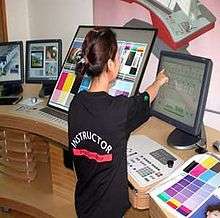Print simulation
Print process simulation uses interactive simulation software to reproduce the operating conditions of complex multi-colour printing presses that often cost several million dollars. Simulators are available for different printing process technologies (Offset Sheetfed, Heatset and Coldset Web Offset; Flexographic and Gravure Packaging), includes their consumables (like inks, plates, paper and other substrates) and where pertinent, in-line packaging operations (such as folding, cutting, label creation).
Simulation in education and training
Press operators get ‘hands-on’ experience in quality control and problem solving without the costs, dangers or unstructured training associated with learning on actual presses. A wide variety of printing conditions and problems are covered that are used for training, skills assessment, performance enhancement and process analysis. Simulation is a means of presenting infrequent problems before they happen so that they can be recognized when they do occur.[1] Exercises can evaluate specific competencies and if they are used to solve problems.[2] When possible, simulators training scenarios are linked to industry-standard curricula like PIA, the NAA (Newspaper Association of America) and the Flexographic Technical Association.[3]
Printing simulation
Typical systems include monitoring and cost analysis that allows the training process to correlate with versus the waste, cost and time on a ‘real’ press.[4] The simulators can either be either connected to a press control console (like the 'cockpit' in a flight simulator) or run on standard micro computer hardware with single or multiple screens. Internet-based learning management systems now allow simulation exercises to be made in a one language/location and reviewed in another language by a training supervisor in a different location – what is traced is the interaction with the process, not the local name of the controls.[5]

1. the pressroom (access to the machine and environment)
2. the printed copy : high contrast, small display
3. the printed copy: lower contract, large display
4. a real operator interface to a process control system
As of 2013 it is estimated that over 2000 print simulators are installed worldwide (in 2013). Users include technical schools, universities, printing companies and their suppliers,[6][7] who find that they cut costs, accelerate training time, and give a more thorough grounding in structured problem solving
Simulators from Sinapse are used alongside real presses in the EuroSkills and WorldSkills competitions to select the best printer.[5][8] Simulation based training is well adapted for the learning habits of today's world [7]
In 2013 the print simulation cloud-based learning system (DLMS) won a PIA (Printing Industries of America) Intertech Award:[9]
Language-independent, it automatically analysed and compares training results from different countries, in different languages.
This DLMS was used at worldskillsLeipzig 2013[10] to analyze and compare results from contestants using simulators in 10+ languages.
References
- RIND Survey, January 2012, "Simulated press problem focusses on tackling production problems"
- Printing News, May 14, 2001, "Useful as Training Assistants, Print Simulators taking off in print shops everywhere"
- ↑ Herman, Peter; Grimaldi, Laurent; Carl, Gerd (19 September 2011–23 September 2011). Development of knowledge and press-test based Heatset training simulator (abstract). 43rd annual conference of the International Circle of Educational Institutes for Graphic Arts, Technology and Management. Norrköping Sweden: International Circle of Teaching Institute for Polygraphic industry. Retrieved 8 March 2013. Check date values in:
|date=(help); External link in|publisher=(help) - ↑ "Useful as Training Assistants, Print Simulators taking off in print shops everywhere".
- ↑ Flexographic Technical Association
- ↑ "Press simulation shows wide variety of uses at Transcontinental Mexico". 9 Mar 2011. Retrieved 8 Mar 2013.
- 1 2 WorldSkills International
- ↑ "Confronting the skills problem". Print & Paper Online Magazine. Apr 2004. p. 247. External link in
|publisher=(help); - 1 2 "Training Generation Y to Work". Wall Street Journal. 4 Mar 2007. Retrieved 8 Mar 2013.
- ↑ Sinapse Print – Training Simulators & Software
- ↑ http://www.printing.org/news/11465
- ↑ https://www.youtube.com/watch?v=eEwRzfregk0